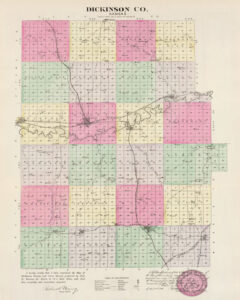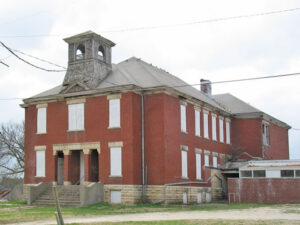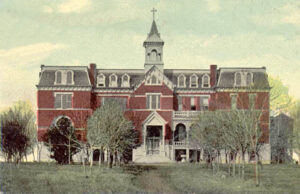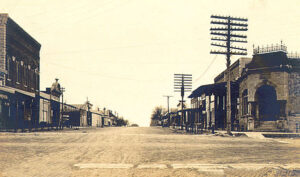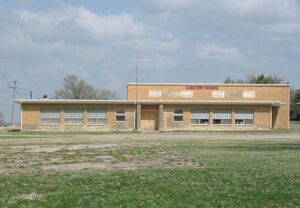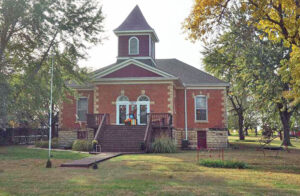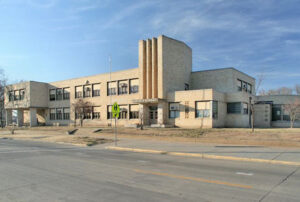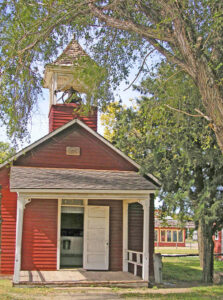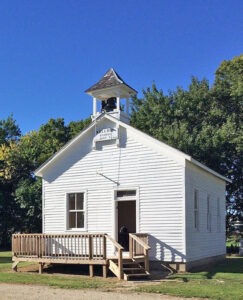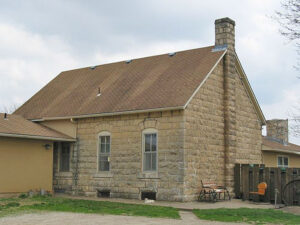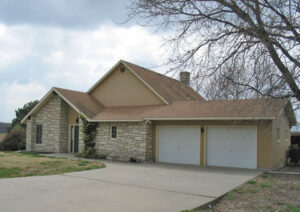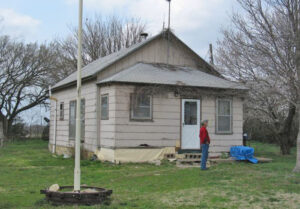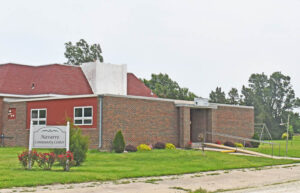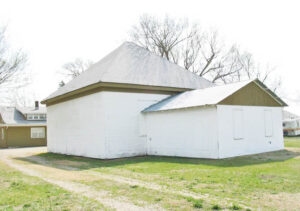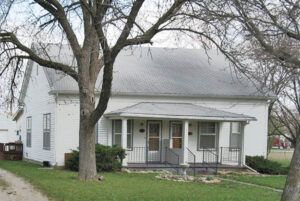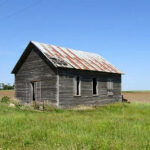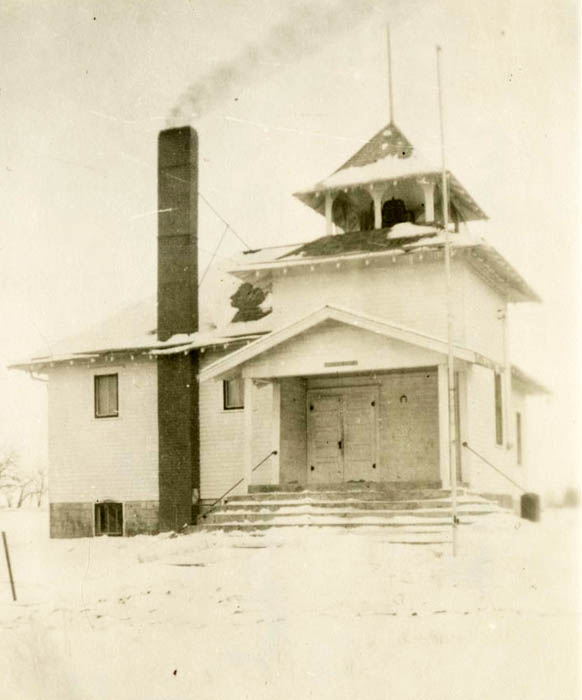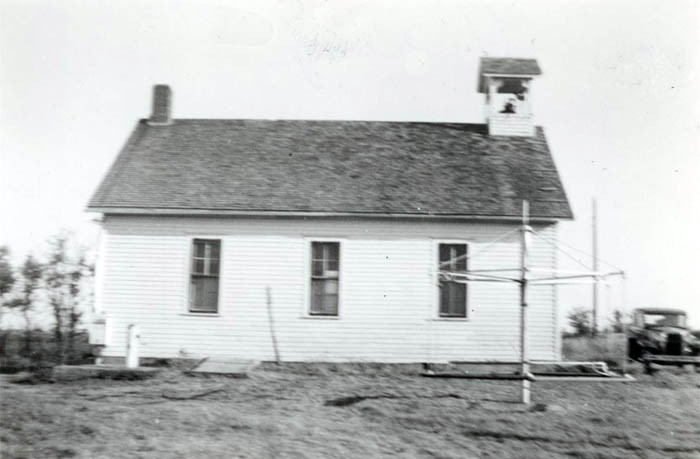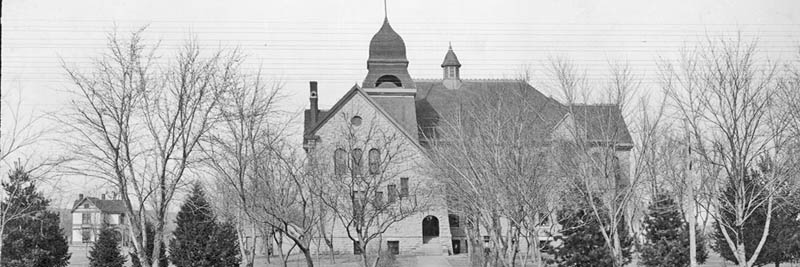
Dickinson County High School in Chapman, Kansas, about 1900.
Dickinson County, Kansas, was organized in 1857, and the first regular election of county officers was held in November 1860.
Samuel Ruthruff was the first person to fill the office of county superintendent of schools in Dickinson County. He was elected in 1860, until April 1864, when he resigned in favor of E. W. Bradfield, who held the office until August 1865. Ex-Superintendent Ruthruff was then appointed for the unexpired term.
The first school was organized in 1863 at Lyona, with Matilda Smith as the teacher, who received a monthly salary of $12.00. For several years, the sessions were held in a log church built by German settlers and fitted with plain board benches for seats. School supplies were scarce. The ox team brought books and slates from Leavenworth. First, the alphabet was mastered, followed by primary reading and number work.
In November 1865, William Frost was elected superintendent and served two years. His successor was William Ramsey, who opened an office in Abilene and vigorously pushed the organization’s work. A school-district map of the county was provided, and at the expiration of his two-year term, the number of schools had increased from three to 22. Most districts owned comfortable stone or wooden buildings, relatively well supplied with furniture and apparatus.
Cyrus Kilgore, the sixth superintendent, was elected in November 1869 and served until the next regular election in 1870, when D. R. Emery was chosen and continued in office until March 1874, the “grasshopper year.” D.W. Wilson, of Solomon City, completed the term by appointment.
A.M. Crary was elected in 1874 and held the office for eight years. During that time, large colonies from the Eastern States settled in the county. The organized schools had increased from 75 to 112, including joint districts with Geary, Clay, Saline, and Marion Counties. The school population had increased to 5,800, and 4,900 were enrolled. The estimated value of the school property was $108,000. The average school term was six months. The monthly salary for male teachers was $37, and for females was $34.
In the early 1880s, the educational interests of the county were in keeping with the general progress and advancement of the other interests of the county. The schoolhouses were all in good condition, and the sites were fenced. The school interiors were well-seated and well-supplied with maps, charts, globes, dictionaries, and other school apparatus. In 1882, there were 112 school districts in the county and 114 schoolhouses, of which three were constructed of brick, eight of stone, and 103 of wood. The school population of the county in 1882, between the ages of five and twenty-one years, was 5,503, divided as to sex into 2,833 males and 2,670 females. The number of students enrolled in the public schools during the year was 4,701, of which 2,397 were males and 2,304 were females. The average daily attendance was 2,757, divided into 1,334 males and 1,423 females. The total number of teachers employed during the year was 133, of which 65 were males and 68 were females. The average monthly salary paid to teachers was $36 for males and $31.50 for females.
Besides the 114 public schools in the county, there were two private schools, giving employment to three male teachers, with a total of 140 students. School bonds were issued during the year to the amount of $13,600, and the total bonded indebtedness of the various school districts in the county was $31,820. The estimated value of all school property in the county, including buildings and grounds, was $95,000. There was in the hands of the District Treasurer, on August 1, 1881, $4,959.45, and the receipts during the year amounted to $57,578.30, totaling $62,537.75. The expenditures during the year amounted to $45,713.29, so on August 1, 1882, the amount in the hands of the District Treasurer was $16,824.46. While there were only 114 schoolhouses in the county, there were 130 schoolrooms, which arose from the fact that the school buildings in Abilene, Solomon City, Enterprise, and Chapman contained two or more rooms. The schoolhouse in Abilene, which had been greatly enlarged to meet the community’s demands, was a large, elegant brick building and would be an ornament to any city.
From 1882 to 1887, D.D. Hornaday, a practical enthusiast for common-school education, ably managed the schools. He completed the organization’s work, leaving 125 districts.
J.S. Ford occupied the office from January 1887 to January 1891. He paid close attention to local and county associations that benefited teachers and patrons. He published a course of study to secure a system for the classification and graduation of students in country schools.
A.C. Van Dyke succeeded Superintendent Ford and served two years. Some marked features of his administration were the appointment of associate examiners not connected with higher schools of learning, labeling applicants’ manuscripts in examination by number instead of by name, establishing local reading circles, publishing reports of school visits through the local press, and increasing the salaries of teachers by raising the standard for third-grade certificates.
Mr. D. F. Shirk was elected superintendent in November 1892, and on January 15, 1893, he was actively engaged in discharging his official duties.
By the early 1890s, each district owned a comfortable frame, brick or stone building fitted out with patent desks and provided with excellent slate, canvas, or native stucco-plaster blackboards. Every schoolroom had wall maps, charts, globes, blocks, and teachers’ registers. Facilities for heating and ventilating received much attention. In 1892, six new schoolhouses were built in country districts, costing $1,000 each. The city of Herington, a railroad center in the southeast part of the county, owned a magnificent brick tower valued at $16,000. Solomon City, on the line of three railways, also had a fine brick structure costing $8,000. Each of these employed seven teachers at very good salaries. The thriving town of Hope, at the Missouri Pacific Railroad and Atchison, Topeka & Santa Fe Railroad crossing, had a neat frame building for $6,000. Chapman, a growing town on the Union Pacific Railroad, spent $5,000 on a schoolhouse built of native limestone. Each of these towns sustained four schools. Enterprise’s public school property was valued at $12,000, and the new brick addition provided the capacity to sustain six schools.
Good two-story school buildings were erected at Banner City, Woodbine, Carlton, Detroit, Dillon, and Manchester.
A love for good literature was cultivated in town and city schools using public libraries and reading tables. There was a growing sentiment in favor of extending these advantages to country schools, and several districts have purchased small libraries with public tax funds.
A system of gradation and graduation for district schools was generally well established. Classification registers were introduced, and all students who completed the adopted course of study and passed a creditable examination in the common-school branches of the State were given certificates of admission to the county high school issued by the county superintendent of schools. This plan secured longer and more regular attendance of students in district schools.
In the spring of 1892, the class of graduates numbered 71.
Teachers and patrons took a lively interest in district and county associations. The county was divided into two institute districts, each governed by a constitution and by-laws and managed entirely by the individual membership. Each district association held six sessions yearly, and the county association had three.
The county was organized into 125 districts, and all children were given excellent school privileges. Very few were compelled to travel over two miles to attend school.
Invariably, each district held but one term of school, the winter term. The average length of the school term was 27 weeks. In all, 150 teachers were employed in the district schools. Male teachers, in 1892, received an average salary of $47.90 per month; females, $39.90; the salary of the county superintendent was $1,200 per annum. The average age of teachers was 22 years. The school population, excluding Abilene, was 6,600; enrollment was 5,300; average daily attendance was 3,400.
In 1892, the districts spent over $61,000 on schooling, costing each pupil $3.58 per capita per inhabitant. The value of the school property belonging to the districts in 1892 was estimated at $140,000, upon which a bonded indebtedness of $62,000 rested. However, these bonds were generally cashed when due.
Practical educators were engaged for four weeks each summer, at good salaries, to conduct a normal institute at the county seat to train people, especially for the profession of teaching. About 140 teachers and others enroll each year. Enrollment and teachers’ examination fees make the institute almost self-sustaining.
By 1959, the number of county schools had dropped to ten.
Abilene City Schools – Prominently associated with the early history of Abilene public schools were ex-probate Judge R.N. Smith and A. V. Jewett, attorneys in Abilene. The former was principal from 1872 to 1873, just at the close of the “Texas cattle trade.” The general character of the school was bad, but the stern and vigilant “master” soon commanded respectful obedience to law and order.
The school property included two substantial brick structures, each three stories high, and two other one-story frame buildings with a capacity of 16 rooms. A portion of the city hall was used for high school purposes. The brick buildings were heated with steam and hot air. Floor ventilators were used, and patent inside shutters were attached to windows to shield students from excessive sunlight. The grounds were the pride of the city. The entire valuation, including furniture and apparatus, was estimated at $75,000, upon which unpaid bonds were paid to the extent of $14,000. The library contained 1,500 volumes, and the reading table was generously supplied with the best periodicals. Nineteen teachers were engaged at an annual outlay of $9,000.
The records for 1892 showed an enrollment of 885, with a daily attendance of 755. About 30 children of various colors attended the lower grades. The course of study embraced eight grades and four years of work in the high school department. High school studies include algebra, geometry, trigonometry, geology, astronomy, ancient history, the United States Constitution, political economy, physics, rhetoric, Latin, and Greek.
Mt. St. Joseph’s Academy – In the northern suburbs of Abilene, a beautiful prairie knoll rose gently above the surrounding country. Here, the largest institution of learning in the county, Mt. St. Joseph’s Academy, was built. It was 120 feet long and 40 feet wide and cost $40,000. It was practically free from any encumbrance.
It was designed especially for a school for girls and as a training department for those who take the vow of sisterhood to the order. The Sisters were self-sacrificing in their duties, and many of them were sent out over the State to take charge of parochial schools. The proceeds from this source and the scholarship tuition fees made the institution self-sustaining. While the parochial schools were fruitful nurseries to the academy, giving it the character of a sectarian school, children of Protestant parents were freely admitted.
Precautionary measures were used to broaden the character of those who attended and to fit them for a successful life. Besides elementary work, instruction was given in music, painting, needlework, shorthand, and typewriting.
The culinary and sleeping apartments were so attractive that they made the institution feel homelike. This institution’s reputation at home and abroad was mainly due to Mother Bernard’s efforts, who took charge of its affairs from the beginning in 1887.
That same year, Kansas was divided into three dioceses, with the sisters’ Motherhouse in the new Diocese of Concordia and the Abilene school remaining in the Diocese of Leavenworth. (Dickinson County became part of the Diocese of Concordia in 1897). Each bishop wanted control of the sisters under his jurisdiction, so in March 1888, the six sisters at the new Abilene school had to decide whether to remain there and become a separate congregation under the Bishop of Leavenworth or return to Concordia. Four remained and became the nucleus of what eventually would become the Sisters of St. Joseph of Wichita. They operated Mount St. Joseph’s Academy until 1912.
German Schools – In connection with the German Lutheran Church organizations on Lyon Creek, two schools were maintained for four to six months each year to give rudimentary instruction in German. One was located in Union Township, the other in Lyon. Plain but neat rooms were fitted for comfort and convenience. The acting pastors taught.
Central College – The Central College Association was organized at Lecompton, Kansas, on July 8, 1891. The corporation formed the board of trustees as follows: Reverend C.M. McKee, Reverend H.E. Rice, Professor H.M. Ambrose, A.M., Reverend E.B. Slade, Reverend J.A. Weller, Ph. D., D.D., Reverend M.R. Myer, M.S., Reverend G.H. Hinton, Reverend S.W. Foulk, Reverend J. Morrison, Reverend S.R. Thom, and Reverend W. S. Blackburn. The same trustees remain in office, except Professor Ambrose, who resigned in June 1892, and Reverend M. Jennings was elected to fill the vacancy. This board of trustees had full control of the institution. In the absence of the board, the association’s affairs were managed by an executive committee, which is limited only by the by-laws and the general direction of the board of trustees.
After the board of trustees was organized, an executive committee consisting of President J. A. Weller, Reverends S.W. Foulk, E.B. Slade, C.M. McKee, and M.R. Myer was directed to go to Enterprise in Dickinson County, Kansas, and accept the college building grounds from the Harrison Normal College Association of Enterprise. This was accomplished on July 10, 1891, and arrangements were made to open the college on September 1, 1891.
The trustees were members of the Church of the United Brethren in Christ and were responsible for their moral and official actions at the conference. Thus, the United Brethren Church has moral control of the institution; the institution’s founding is officially approved by three out of four state conferences.
The college building is a beautiful and substantial structure, 65×70 feet, three stories, 15 rooms, built of gray limestone. The architecture is modern, and the rooms and hall were finished in hard pine and oak with an oil finish. Other buildings were soon to be erected. Private parties owned the boarding halls. The college building and the block upon which it stands cost $20,000. There were 500 lots, worth at least $50,000, belonging to the college and the college block. The location is beautiful, with a splendid view of the surrounding country.
The college’s primary objective is to pursue studies under the influence of the church and Christian teachers. Revivals of religion were encouraged. The Y.M.C.A. and Y.W.C.A. give a religious tone to the college.
Students were offered a choice of courses of study and many elective studies. The courses were classical, scientific, literary, commercial, normal, preparatory, instrumental, and vocal music, fine art, shorthand, and typewriting. The college year is divided into four terms of 10 weeks each. The tuition was $8 for college studies or shorthand and typewriting, and $10 for commercial studies and instrumental music.
There were ten professors and teachers employed. The faculty included J.A. Weller, D.D., Ph. D., president and professor of philosophy and pedagogy; Emma H. Weller, A.M., professor of Latin and Greek languages; T. D. Crites, B. S., professor of natural science; L. D. Arnold, B. S., professor of mathematics; D. L. Hoastson, M. Accts., professor of commerce; Reverend G.G. Grassmucck, A. M., instructor of German language; Jno. Van Wordragen, dean of music; Mabel I. Poulton, assistant in music; J. W. Ehrsam, B. S., instructor in mechanical drawing; and Mrs. R.M. Foster, instructor in fine art. The faculty comprises learned and energetic men and women in the prime of life. Miss Mary Kness is an assistant teacher in the English language.
The management of the college was committed to the president. The faculty had regular weekly meetings in which plans for managing and inspiring the classes were developed. The general control of the college building and the management of the students is committed to the president by the institution’s by-laws. The literary societies, the Platonian for gentlemen and the Emersonian for ladies, were under the general direction of the faculty, and their literary work was under their supervision. The college grew steadily. The total enrollment for the first year was 147; in December 1892, it was 185 students. At the time of the college’s organization, the library had 300 volumes. In addition to this nucleus of a library, the students had free access to 1,000 volumes belonging to the president and Mrs. Weller. The college’s apparatus was continually increasing. By solicitation and entertainment, the Ladies’ College Aid Society had gathered a fund to equip the college with apparatus. The electric apparatus, microscope, etc., already obtained were first class. A good beginning has been made in the way of gathering a museum. The selections were good and were awakening a new interest in the college. A taxidermy class was supplying the college with some excellent specimens.
The president, Reverend J.A. Weller, D.D., Ph. D., was born in Morgan County, Ohio, on April 28, 1846. After his common-school training and service in the army, being a private in Co. K, 161st Ohio Volunteer Infantry, he settled on a farm until August 1871, when he entered Otterbein University, Westerville, Ohio. From this institution, he graduated in June 1876 with the degree of A.B. In the summer of 1877, he graduated from the National School of Elocution and Oratory of Philadelphia, Pennsylvania. In May 1878, he graduated from Union Biblical Seminary of Dayton, Ohio. During the next two years, he served as pastor of the United Brethren Church at Marion, Ohio, where he was called as college pastor to Otterbein University, his alma mater. At the end of one year, he was unexpectedly called to the chair of ancient languages at Western College in Toledo, Iowa. He gave life and enthusiasm to this department for six years when he became president of Lane University at Lecompton, Kansas. This college was then in a dilapidated condition. The institution had run so low that its note would not be taken in the bank.
Despite numerous obstacles to establishing a college in the town, the college grew to an enrollment of 330 students during the fourth year of his presidency. He solicited $25,000 from Lane University. Much of President Weller’s success as an educator is due to his faithful wife, Reverend Emma Howard Weller, who was married on January 1, 1883, at Clear Lake, Iowa. She was 35 years of age and had been a teacher for 18 years. Besides teaching for several years in the common schools of Iowa, she taught painting and drawing during the five years she was a student at Western College in Toledo, Iowa. She earned a B.S., A.B., and A.M. from her alma mater. She filled the chair of Latin and English languages at Lane University and was a Latin and Greek languages professor at Central College. The president and Mrs. Weller were noted for their energy, enthusiasm, and devotion to building up the college. Central College, with the principle of keeping out of debt, had a bright future before it. Enrollment at the beginning of the second year of 185 students representing 25 counties of the State of Kansas foretold remarkable energy and life. It brought excellent citizenship to Enterprise, a manufacturing city with 900 inhabitants.
Today, there are five school districts in Dickinson County:
- Abilene USD 435 is a public unified school district headquartered in Abilene, Kansas. The district includes the communities of Abilene, Talmage, and nearby rural areas.
- Chapman USD 473 – This district is headquartered in Chapman, Kansas. It includes the communities of Chapman, Acme, Carlton, Detroit, Enterprise, Industry (south of 1st Rd), Lyona, Manchester, Navarre, Pearl, Wreford, Buckeye, Elmo, Holland, Moonlight, Upland, Sutphen, and nearby rural areas.
- Herington USD 487—This school district is headquartered in Herington, Kansas. It includes the communities of Herington, Shady Brook, and nearby rural areas.
- Rural Vista USD 481 – Headquartered in White City, Kansas, the district includes the communities of Hope, White City, Woodbine, Latimer, Parkerville, Skiddy, Dillon, Shady Brook, and nearby rural areas of Dickinson and Morris Counties.
- Solomon USD 393 – Headquartered in Solomon, Kansas, the district includes the communities of Solomon, New Cambria, Niles, Verdi, and nearby rural areas.
Dickinson County Historic Schools
| Name | District | Years of Operation | Location & Information |
| Carlton | 17 | 1855-1880s |
A new school was built in Carlton, Kansas, in 1955. The L-shaped brick and stone building with glass block and hopper windows has a gymnasium in the rear. In the 1880s, the school was consolidated with those in Chapman, Kansas. Today, it is used as a community center and a city building. It is located on West Main Avenue. Carlton, Kansas, is a ghost town today. |
| Dayton | ?? | 1900-?? |
The former rural wood frame school was relocated to Hope, situated south of Hope High School, and is now used as a Kindergarten. It is now used as an Art classroom. It once stood in the extinct town of Dayton, about 16 miles south of Abilene. It is located at 200 Poplar Street in Hope, Kansas. |
| Detroit | ?? | 1907-1967 |
This is the third Detroit School building in this location. The building, constructed in 1907, began as a two-room school. A third room was added on the west side in 1914. The school’s last year was the 1966-1967 term. It served as the Detroit Community Center from 1968 to 1988, when a private party bought it. It is located at 2331 W Detroit Street in Abilene, Kansas. |
| Garfield Elementary | ?? | 1942-? |
The Garfield Elementary School was built in 1942 with the assistance of the Federal Works Administration. A review of school board minutes and local media coverage of the school’s planning and construction portrays an emphasis on modern accouterments, attention to functional aspects of the school’s use, consideration of maintenance and performance of materials, and planning for future expansion. The school was constructed using a $50,000 Works Progress Administration grant and city bonds. The design strongly references Frank Lloyd Wright’s textile block architecture at the entrances. The two-story brick building, built in the Streamlined/Art Moderne style, serves as apartments today. It was listed on the National Register of Historic Places in November 2009. It is located at 300 Northwest 7th Street in Abilene, Kansas. |
| Grove Hill | ?? | ??-1945 |
The Grove Hill schoolhouse was located in Lincoln Township, about four miles northwest of Abilene. This one-room schoolhouse was the first wood-framed schoolhouse in Dickinson County. The school was donated and moved to the newly organized Old Abilene Town in 1959. The Grove Hill Schoolhouse was located near Sand Springs in Section 9 of Lincoln Township, just a few miles northwest of Abilene. The schoolhouse was equipped with old-fashioned folding seat desks. The original desks and other furnishings, as well as original wall maps and blackboards, were included in the move. The schoolhouse was located on the Tracy Conklin farm. The Conklins donated the schoolhouse. The last year the school was held here was in 1945. It now stands in Old Abilene Town at 200 SE 5th Street in Abilene. |
| Kellogg | 3 | 1887-1954 |
The Kellogg School District 3 was organized in 1868. The Kellogg schoolhouse was built in 1887, and several anterooms were added later. One was for coats, and one was for coal. District 3 ceased to exist when the Upland District 127 was created in the mid-1950s, but the Kellogg School continued to be used for a few years until District 127 consolidated with the Chapman district. The school closed in 1954. It was located northwest of Chapman. The schoolhouse was moved to the Heritage Center Museum in Abilene. |
| Lyona | 1 | 1901-1950 |
The old rectangular Lyona School, built of native stone in the vernacular style in 1901, operated as a school until 1950. In the 1960s, it was converted into a residence. Due to additions, the original building is barely visible from the front. It is located at 1697 Wolf Road in Woodbine, Kansas.
|
| Maple Grove | 1930-1960s |
The old Maple Grove Schoolhouse is a wood frame with a native stone foundation built in the Vernacular style. The rectangular building was converted into a residence after the school closed in the 1960s. It is located at 1097 K-43 in Hope, Kansas.
|
|
| Old Brick Schoolhouse | ?? | 1930-?? | This old red brick square building was designed in the Vernacular style with a hip roof and a projecting gabled central entry. The old schoolhouse was converted into a residence. South of the house, there is a wood-frame garage and shed. It is located at 1198 Old Highway 40 near Abilene, Kansas. |
| Navarre School | ?? | ?? |
This one-story T-shaped brick building was erected in the Commercial style with a Mansard roof. A one-story modern brick addition on the front of the building obscures the front of the original building. Today, it is a community center located on 2nd Street in Navarre, Kansas.
|
| Prairie Union | 68 | 1900-?? |
This is a one-story wood-frame Vernacular-style square building with a hip roof. The former school building was moved to Hope, Kansas, and is used as a garage by a funeral home that occupies a former residence. It is located at 106 N. 2nd Street in Hope, Kansas. |
| Ramona | 1900-?? |
This rectangular vernacular-style wood frame structure has a gable roof, hip front porch, and rear shed additions. This former rural school was moved into Hope and converted into a duplex. Ancillary structures include garages northeast and northwest of the building. The old Ramona Schoolhouse is located at 114-116 2nd Avenue in Hope, Kansas. |
|
| Sand Springs | 9 | ?? |
The old school is at 2149 Eden Rd, in Abilene, Kansas. |
| Victory | 56 | 1872-1950 |
District 56 was organized in 1872. The school was moved a couple of times. In April 1949, the board of Victory School decided to close the school. The weathered building still stands. |
| Woodbine High | 1915-1962 |
This two-story T-shaped brick and stone building was designed in the commercial style with an intersecting hip roof and a bell tower. The gymnasium with a metal gable roof is attached to a one-story addition. The high school closed in 1962, but the gymnasium is occasionally used for community activities. The building is deteriorating; the windows are boarded up, and the chimney has collapsed. A playground is on the south side. Vacant today, it is located on Webster Street in Woodbine, Kansas. |
Dickinson County Historic School Districts
| School | District | Years of Operation | Location | School | District | Years of Operation | Location | |
| Abilene Baptist Academy | ?? | ?? | Kellogg | 3 | 1887-1954 | Abilene, KS | ||
| Abilene High School | ?? | ?? | Kennedy Elementary | ?? | ?? | Abilene, KS | ||
| Abilene Middle School | ?? | ?? | Keystone | 38 | ?? | Abilene, KS | ||
| Alida | 86 | ?? | Laney | 96 | Late 1800s to the mid-1900s. | |||
| Belle Springs | 54 | ?? | Lyona | 1 | 1901-1950 | |||
| Blue Ridge Elementary | ?? | ?? | Manchester | ?? | ?? | |||
| Bonaccord | 98 | ?? | Maple Grove | ?? | 1930-1960s | Hope, KS | ||
| Carlton | 17 | 1855-1880s | McKinley Elementary | ?? | ?? | Abilene, KS | ||
| Carry Creek | ?? | ?? | Mt. St. Joseph Academy | ?? | ?? | |||
| Central College | ?? | ?? | Navarre | 13 | ?? | |||
| Chapman Elementary | ?? | ?? | New Basel | 52 | ?? | |||
| Chapman High School | ?? | ?? | New Chillicothe | 3 | ?? | Chapman, KS | ||
| Chapman Middle School | ?? | ?? | Old Brick Schoolhouse | ?? | 1930-?? | Chapman, KS | ||
| College Hill | ?? | ?? |
This school was on the border of Marion and Dickinson Counties. |
Philomathea | 54 | Newbern Township | ||
| Dayton | ?? | 1900-?? | Prairie Union | 68 | 1900-?? | |||
| Delhi | 73 | 1878-1947 | Prospect | 4 | ||||
| Detroit | 11 | 1907-1967 | Ramona | ?? | 1900-?? | Detroit, KS | ||
| Dickinson County High | ?? | ?? | Prairie Union | 68 | 1900-?? | |||
| Dillon | ?? | ?? | Prospect | 4 | ||||
| Elmo | 19 | ?? | Ramona | 1900-?? | ||||
| Enterprise Elementary | 16 | ?? | Redwood | 90 | ?? | |||
| Garfield Elementary | ?? | 1942-?? | Rhodes | 56 | ?? | |||
| Glenwood | 95 | 1879-1948 | A marker is at the intersection of Highway 18 and Gulf Road. | Rural Center Elementary | ?? | ?? | Abilene, KS | |
| Greenridge | 21 | ?? | In Sherman Township. | St. Andrews S Elementary, | ?? | ?? | Abilene, KS | |
| Grove Hill | ?? | ??-1945 | Sand Springs | 9 | ?? | |||
| Harvey | ?? | ?? | Solomon Elementary | 1 | ?? | |||
| Herington Elementary | ?? | ?? | Solomon High School | 1 | ?? | Herrington, KS | ||
| Herington Middle School | ?? | ?? | Spring Valley | ?? | Herrington, KS | |||
| Herington High School | ?? | ?? | Sunnyside | 76 | ?? | Herrington, KS | ||
| Hiawatha | ?? | ?? | Victory | 56 | 1872-1950 | |||
| Holland | 36 | ?? | Walnut Grove | ?? | ?? | |||
| Hope Elementary | ?? | ?? | White City Elementary | ?? | ?? | Hope, KS | ||
| Hope High School | ?? | ?? | White City High School | ?? | ?? | Hope, KS | ||
| Industry | 70 | ?? | Woodbine High | 14 | 1915-1962 | Industry, KS |
©Kathy Alexander/Legends of Kansas, updated July 2025.
Also See:
Dickinson County Photo Gallery
One-Room, Country, & Historic Schools of Kansas
Sources:
Blackmar, Frank W.; Kansas: A Cyclopedia of State History, Vol I; Standard Publishing Company, Chicago, IL 1912.
Cutler, William G.; History of Kansas; A. T. Andreas, Chicago, IL, 1883
Kansas State Historical Society, The Columbian History of Education in Kansas, Hamilton Printing Company, Topeka, KS, 1893
Kansas Historic Resources Inventory

